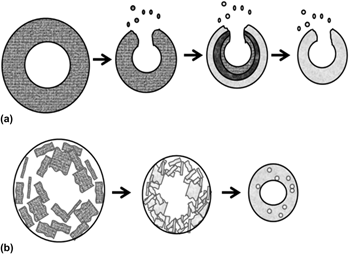Crossref Citations
This article has been cited by the following publications. This list is generated based on data provided by
Crossref.
Cho, Yun Kyeong
Jung, Kyeong Youl
Lee, Hyunmi
and
Heo, Soonyoung
2013.
Synthesis and characterization of C/Cu core–shell particles by hydrogen-free spray pyrolysis assisted with citric acid and sucrose.
Materials Research Bulletin,
Vol. 48,
Issue. 9,
p.
3424.
Zhong, Kai
Peabody, George
Blankenhorn, Elizabeth
Glicksman, Howard
and
Ehrman, Sheryl
2013.
Spray pyrolysis of phase pure AgCu particles using organic cosolvents.
Journal of Materials Research,
Vol. 28,
Issue. 19,
p.
2753.
Shen, Yafei
2015.
Carbothermal synthesis of metal-functionalized nanostructures for energy and environmental applications.
Journal of Materials Chemistry A,
Vol. 3,
Issue. 25,
p.
13114.
Xu, Xia
Park, Jihoon
Hong, Yang-Ki
and
Lane, Alan M.
2015.
Ethylene glycol assisted spray pyrolysis for the synthesis of hollow BaFe12O19 spheres.
Materials Letters,
Vol. 144,
Issue. ,
p.
119.
Sun, Shaodong
Yang, Qing
Liang, Shuhua
and
Yang, Zhimao
2017.
Hollow CuxO (x = 2, 1) micro/nanostructures: synthesis, fundamental properties and applications.
CrystEngComm,
Vol. 19,
Issue. 42,
p.
6225.
Tang, Justin
Wang, Hailiang
and
Gomez, Alessandro
2017.
Controlled nanoparticle synthesis via opposite-polarity electrospray pyrolysis.
Journal of Aerosol Science,
Vol. 113,
Issue. ,
p.
201.
Liang, Yujia
Felix, Ryan
Glicksman, Howard
and
Ehrman, Sheryl
2017.
Cu-Sn binary metal particle generation by spray pyrolysis.
Aerosol Science and Technology,
Vol. 51,
Issue. 4,
p.
430.
Liang, Yujia
Oh, Su Cheun
Wang, Xizheng
Glicksman, Howard
Liu, Dongxia
and
Ehrman, Sheryl
2017.
Oxidation-resistant micron-sized Cu–Sn solid particles fabricated by a one-step and scalable method.
RSC Advances,
Vol. 7,
Issue. 38,
p.
23468.
Qu, Yang
Wangyang, Peihua
Humayun, Muhammad
Sun, Li
Batter, Buhe
and
Li, Zhijun
2017.
Coordination and reduction in polyol-mediated solvothermal synthesis of nickel-based materials with controllable morphology and magnetic and electrochemical properties.
Research on Chemical Intermediates,
Vol. 43,
Issue. 11,
p.
6395.
You, Junhua
and
Guo, Yaozu
2018.
One-step synthesis of L10FePt particles through spray pyrolysis: the impacts of post annealing on product morphology and magnetic properties.
Materials Research Express,
Vol. 5,
Issue. 2,
p.
026103.
Felix, Ryan
Repac, Joseph
Liang, Yujia
Urooj, Afshan
Glicksman, Howard
and
Ehrman, Sheryl
2018.
Copper–zinc particles with zinc-enriched surfaces generated via spray pyrolysis.
Aerosol Science and Technology,
Vol. 52,
Issue. 9,
p.
984.
Liang, Yujia
Wu, Wei
Wang, Peng
Liou, Sz-Chian
Liu, Dongxia
and
Ehrman, Sheryl H.
2018.
Scalable fabrication of SnO2/eo-GO nanocomposites for the photoreduction of CO2 to CH4.
Nano Research,
Vol. 11,
Issue. 8,
p.
4049.
Septiani, Eka Lutfi
Kikkawa, Jun
Cao, Kiet Le Anh
Hirano, Tomoyuki
Okuda, Nobuhiro
Matsumoto, Hiroyuki
Enokido, Yasushi
and
Ogi, Takashi
2021.
Direct synthesis of submicron FeNi particles via spray pyrolysis using various reduction agents.
Advanced Powder Technology,
Vol. 32,
Issue. 11,
p.
4263.
Ratnasari, Delyana
Septiani, Eka Lutfi
Cao, Kiet Le Anh
Hirano, Tomoyuki
Okuda, Nobuhiro
Matsumoto, Hiroyuki
and
Ogi, Takashi
2023.
Synthesis of Submicron-Sized Spherical Silica-Coated Iron Nickel Particles with Adjustable Shell Thickness via Swirler Connector-Assisted Spray Pyrolysis.
Langmuir,
Vol. 39,
Issue. 39,
p.
14063.
